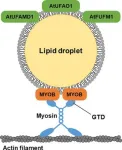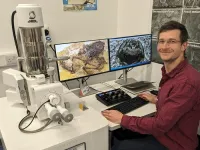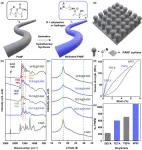(Press-News.org) Lipids are biomolecules essential for the proper functioning of the living cell, ranging from comprising cell membranes to forming integral components of cell signaling pathways. Plant cells possess cell subcellular structures or organelles called lipid droplets (LDs) in the leaves and seeds, which store excess lipids (fats).
Recent studies have shown that LDs also localize unique plant proteins that perform essential molecular functions. For example, seed LDs localize plant proteins called oleosins, which help seeds weather freezing temperatures and germinate properly. With an expanding body of proof that LDs are not just organelles for carbon storage but may also perform essential molecular functions, a group of researchers from Japan sought to understand the role of the relatively unexplored leaf LDs. Associate Professor Takashi L. Shimada, an LD expert affiliated with Chiba University, explains the motivation behind their research, “We have a limited understanding of the functions of leaf LDs—why do plant leaves accumulate LDs at all? We believe the answer to this fundamental question would also contribute to lipid production technology.”
In a new pioneering study published in Frontiers in Plant Science on 01 March 2024, Dr. Shimada and his research group showed that leaf LDs localized myosin binding proteins essential for intracellular movements and enzymes that catalyze furan fatty acid biosynthesis—a type of fat production in living cells—highlighting the potential and previously undiscovered molecular functions of LDs. This research was led by Dr. Shimada, who is associated with the Graduate School of Horticulture, Plant Molecular Science Center, and Research Center for Space Agriculture and Horticulture at Chiba University, Japan. His research group also involved Mr. Yuto Omata from the Faculty of Horticulture, Chiba University, who is the first author of this study, along with Dr. Emi Mishiro-Sato, lecturer at World Premier International Research Center Initiative-Institute of Transformative Bio-Molecules, Nagoya University, and Dr. Ikuko Hara-Nishimura and Dr. Haruko Ueda from the Faculty of Science and Engineering, Konan University in Japan.
The researchers used an Arabidopsis plant model mutated to accumulate LDs in the leaves called Arabidopsis thaliana mutant high sterol ester 1. Dr. Shimada adds, “This Arabidopsis plant mutant model also serves as a valuable resource for further studying the leaf LD proteome.”
Further, the researchers isolated these leaf LDs and used mass spectrometry to identify associated proteins. They found 3,206 candidate proteins. Furthermore, they focused on 31 candidate proteins to test associated behavior in leaf LDs. They attached a fluorescent marker to these proteins to facilitate microscopic observations.
The fluorescence microscopy revealed the presence of MYOSIN BINDING PROTEIN14 (MYOB14) and two uncharacterized proteins in the leaf LDs under investigation. Further examination narrowed down the MYOB family members localized to leaf LDs: MYOB1, MYOB2, MYOB3, and MYOB5. The researchers also identified the two uncharacterized proteins as resembling enzymes for furan fatty acid biosynthesis, suggesting a potential link between leaf LDs and the type of fatty acid production.
Despite the progress made in this study, Dr. Shimada cautions about the need for further studies on leaf LDs, “We need to identify additional leaf LD proteins to resolve the molecular and physiological functions of leaf LDs.”
Nonetheless, the study paves the way for future research in leaf LDs—a relatively untapped plant resource—that could revolutionize lipid production and associated industries, all thanks to the efforts of Dr. Shimada and his team.
About Associate Professor Takashi L. Shimada
Dr. Takashi L. Shimada works in the Graduate School of Horticulture, Plant Molecular Science Center, and Research Center for Space Agriculture and Horticulture at Chiba University, Japan. Dr. Shimada investigates the intracellular structure of plants, especially lipid droplets. His research aims to comprehensively understand lipid storage in plants and enhance plant lipid production for potential application as a food resource. He has co-authored more than 20 reputed publications and is a member of multiple academic societies, including the Japanese Association of Plant Lipid Researchers and The Phytopathological Society of Japan.
END
Unveiling the molecular functions of lipid droplet proteins in Arabidopsis thaliana leaves
Researchers characterize leaf lipid droplet proteins, shedding light on their potential roles in lipid movement and fat production catalysis
2024-04-23
ELSE PRESS RELEASES FROM THIS DATE:
Perfecting the view on a crystal’s imperfection
2024-04-23
NEW YORK, April 23, 2024 — Single-photon emitters (SPEs) are akin to microscopic lightbulbs that emit only one photon (a quantum of light) at a time. These tiny structures hold immense importance for the development of quantum technology, particularly in applications such as secure communications and high-resolution imaging. However, many materials that contain SPEs are impractical for use in mass manufacturing due to their high cost and the difficulty of integrating them into complex devices.
In 2015, scientists discovered SPEs within a material called hexagonal boron nitride (hBN). Since then, hBN has gained widespread attention and ...
Fossil frogs share their skincare secrets
2024-04-23
Palaeontologists at University College Cork (UCC), Ireland, have solved a hundred-year-old mystery of how some fossil frogs preserve their fleshy parts – it’s all down to their skin.
Palaeontologists Daniel Falk and Prof. Maria McNamara, together with scientists from Ireland, Germany and the UK, studied 45-million-year-old fossil frogs from the Geiseltal site in central Germany. Remarkably, the fossils show full body outlines of the soft tissues. The team discovered that the excellent condition of the fossil frogs is due to preservation of ancient skin remnants.
The team studied the fossils with high-precision ...
Existing drugs studied in patients with rare immune diseases
2024-04-23
Existing drugs studied in patients with rare immune diseases
This month the first study within the DRIMID consortium (DRIMID stands for Drug Rediscovery for Rare Immune Mediated Inflammatory Diseases) has started. This study will investigate the efficacy and safety of the drug filgotinib (approved for treatment of rheumatoid arthritis and ulcerative colitis) in three rare immune diseases (Behçet's disease, idiopathic inflammatory myositis, IgG4-related disease). DRIMID aims to investigate whether this drug - despite the absence of formal ...
Loma Linda University study reveals alarming rates of pediatric injuries from mechanical bull riding
2024-04-23
A new study conducted by researchers at Loma Linda University Children’s Health has shed light on the alarming rates of pediatric injuries resulting from mechanical bull riding. The study, titled "Mechanical Bull Injuries in Pediatric Patients: A Call for Safety Regulations," highlights the urgent need for enhanced safety measures and regulations.
The findings were published in the journal Children's Health Care and revealed that mechanical bull riding poses a significant risk to children, with traumatic brain injuries being the most common outcome.
“Mechanical bulls, even when ...
Excessive pregnancy weight gain and substantial postpartum weight retention common in military health care beneficiaries
2024-04-23
ROCKVILLE, Md.— Compared to their civilian counterparts, excessive pregnancy weight gain is more frequent among military health care beneficiaries, in particular active duty personnel, and is associated with costly maternal/neonatal complications. Women in this sample with excessive pregnancy weight gain were also three times more likely to have substantial postpartum weight retention, according to a new study published in the journal Obesity, The Obesity Society’s (TOS) flagship journal.
Substantial weight retention ...
Odor-causing bacteria in armpits targeted using bacteriophage-derived lysin
2024-04-23
Body odor from the armpits comes from bacteria metabolizing sweat produced by the apocrine glands. These bacteria are native to our skin, but the odors produced differ among people. Generally, people use deodorants on their armpits, but perhaps there is a way to get rid of the bacteria.
To find out, a research team led by Osaka Metropolitan University Professor Satoshi Uematsu and Associate Professor Kosuke Fujimoto at the Graduate School of Medicine collected body fluid samples from the armpits of 20 men that were deemed healthy. In advance, a subjective olfactory panel classified ...
Women’s heart disease is underdiagnosed, but new machine learning models can help solve this problem
2024-04-23
When it comes to matters of the heart, cardiovascular disease in women is underdiagnosed compared to men. A popular scoring system used to estimate how likely a person is to develop a cardiovascular disease within the next 10 years is the Framingham Risk Score. It is based on factors including age, sex, cholesterol levels, and blood pressure.
Researchers in the US and the Netherlands have now used a large dataset to build more accurate cardiovascular risk models than the Framingham Risk Score. They also quantified the underdiagnosis of women compared to men. The results were published in Frontiers ...
Extracting high-purity gold from electrical and electronic waste
2024-04-23
Korea relies on imports for most of its metal resources, and in recent years, due to resource depletion and rising raw material prices, 'circular resources' that recycle waste metal resources have emerged. In response, SK hynix has established a mid- to long-term plan to increase the percentage of copper, gold, etc. recovered and reused from waste generated in the semiconductor manufacturing process to more than 30% by 2030, and Samsung Electronics is running a collection program for used mobile phones in cooperation with E-circulation Governance, a non-profit corporation. The global circular economy market is expected ...
Tropical fish are invading Australian ocean water
2024-04-23
A University of Adelaide study of shallow-water fish communities on rocky reefs in south-eastern Australia has found climate change is helping tropical fish species invade temperate Australian waters.
“The fish are travelling into these Australian ecosystems as larvae caught in the Eastern Australian Current, which is strengthening due to the warming climate,” said the University of Adelaide’s Professor Ivan Nagelkerken, Chief Investigator of the study.
“These larvae would not normally survive in the cooler Australian ...
No bull: How creating less-gassy cows could help fight climate change
2024-04-23
A Curtin University study has revealed breeding less-flatulent cows and restoring agricultural land could significantly reduce rising methane emission levels, which play a considerable role in climate change.
The food system, including grazing animals such as cows, generates major sources of methane mainly due to cattle digestion, manure decomposition and land use for grazing.
To look for solutions, researchers from the Curtin University Sustainability Policy Institute analysed 27 academic publications and identified dozens of potential strategies to reduce methane emissions from Australia’s beef and dairy sectors.
Study ...
LAST 30 PRESS RELEASES:
Injectable breast ‘implant’ offers alternative to traditional surgeries
Neuroscientists devise formulas to measure multilingualism
New prostate cancer trial seeks to reduce toxicity without sacrificing efficacy
Geometry shapes life
A CRISPR screen reveals many previously unrecognized genes required for brain development and a new neurodevelopmental disorder
Hot flush treatment has anti-breast cancer activity, study finds
Securing AI systems against growing cybersecurity threats
Longest observation of an active solar region
Why nail-biting, procrastination and other self-sabotaging behaviors are rooted in survival instincts
Regional variations in mechanical properties of porcine leptomeninges
Artificial empathy in therapy and healthcare: advancements in interpersonal interaction technologies
Why some brains switch gears more efficiently than others
UVA’s Jundong Li wins ICDM’S 2025 Tao Li Award for data mining, machine learning
UVA’s low-power, high-performance computer power player Mircea Stan earns National Academy of Inventors fellowship
Not playing by the rules: USU researcher explores filamentous algae dynamics in rivers
Do our body clocks influence our risk of dementia?
Anthropologists offer new evidence of bipedalism in long-debated fossil discovery
Safer receipt paper from wood
Dosage-sensitive genes suggest no whole-genome duplications in ancestral angiosperm
First ancient human herpesvirus genomes document their deep history with humans
Why Some Bacteria Survive Antibiotics and How to Stop Them - New study reveals that bacteria can survive antibiotic treatment through two fundamentally different “shutdown modes”
UCLA study links scar healing to dangerous placenta condition
CHANGE-seq-BE finds off-target changes in the genome from base editors
The Journal of Nuclear Medicine Ahead-of-Print Tip Sheet: January 2, 2026
Delayed or absent first dose of measles, mumps, and rubella vaccination
Trends in US preterm birth rates by household income and race and ethnicity
Study identifies potential biomarker linked to progression and brain inflammation in multiple sclerosis
Many mothers in Norway do not show up for postnatal check-ups
Researchers want to find out why quick clay is so unstable
Superradiant spins show teamwork at the quantum scale
[Press-News.org] Unveiling the molecular functions of lipid droplet proteins in Arabidopsis thaliana leavesResearchers characterize leaf lipid droplet proteins, shedding light on their potential roles in lipid movement and fat production catalysis








